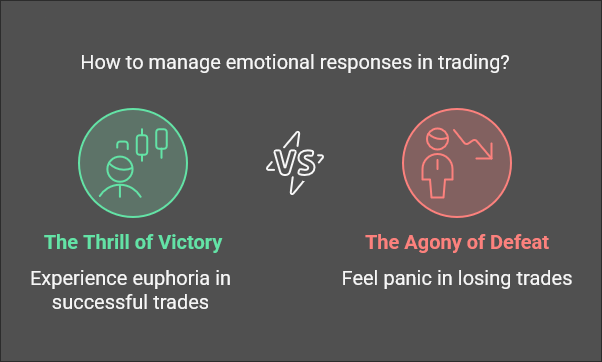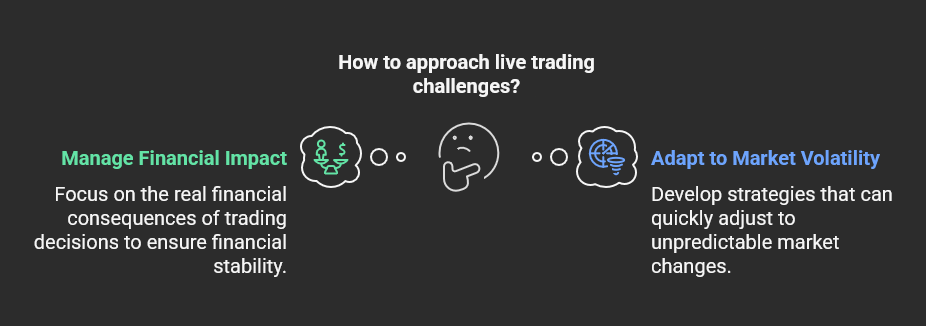Paper Trading vs. Live Trading: What Every Trader Should Know
Paper Trading vs. Live Trading: What Every Trader Should Know
In trading, where every second counts and market movements can flip trading accounts in the blink of an eye, many investors find themselves wrestling with a crucial question: is paper trading just an exercise in basic technical analysis or a legitimate pathway to becoming a savvy trader? Will this form of practice reduce my risk of loss? Will it make my trading relatively easy to execute? If you’re juggling a full-time job while trying to navigate the complexities of stock and cryptocurrency markets, you may have come across virtual trading as a potential solution to help you develop profitable investment strategies. But let’s face it, who wouldn’t want to dive into real trades rather than testing the waters with hypothetical scenarios on a stock market simulator?
Paper trading empowers both new and experienced traders to simulate real-market conditions without financial risk and can help them learn the basics of trading. It’s like playing dress-up for your investment strategy—complete with all the excitement but none of the threats to your bank account! Yet, while it serves its purpose in honing skills and building confidence, it’s essential to understand that this practice may not fully replicate the emotional highs and lows of real-time trading.
As we explore the nuances between paper (a/k/a practice) trading and live trading, we’ll uncover insights that can elevate your investment journey. From discovering how psychological factors influence decision-making to understanding risk management in real-time, this discussion will equip you with actionable strategies to conquer Wall Street—both in theory and practice.
Understanding Paper Trading
When you embark on the journey of paper trading, you step into a virtual arena where every move is tracked, but none of your hard-earned cash is at risk. Think of it as a thrilling practice session before the big game—where the pressure is off, but the lessons learned can be invaluable.
So, what exactly does this form of trading entail? Simply put, it allows traders to buy and sell securities in a simulated environment. Here’s why paper trading is essential for both rookies and seasoned players:
- Skill Development: Paper trading provides a safe space to learn the ropes. You can experiment with different strategies and styles without the fear of financial loss. It’s like riding a bike with training wheels—eventually, you’ll want to ride without them!
- Market Understanding: By engaging in mock trades, you gain insights into how various market conditions affect your trades. This knowledge will serve you well when the stakes are real.
- Error Analysis: Mistakes are part of learning. With a demo trading account, you can identify and analyze errors without remorse. This reflection helps refine your strategies for future success.
- Strategy Testing: Before you commit real capital to any approach, test it out in a low-pressure environment. This method can help validate or invalidate your strategies effectively.
The Emotional Factor
One critical aspect that paper trading does not capture is the emotional rollercoaster that accompanies real-time trading. The thrill of making profits can quickly turn into anxiety during downturns; emotions like fear and greed often cloud judgment.
"In paper trading, there’s no ‘what if’ panic driving decisions—just data and analysis." - A seasoned trader
A Bridge to Live Trading
For those working during regular hours and unable to participate in live markets, paper trading acts as a bridge connecting theoretical knowledge with practical application. It offers flexibility; you can trade stocks at your convenience— whether it’s early morning before work or late at night after unwinding from a long day.
However, remember that while virtual environments provide invaluable tools for growth, they should complement rather than replace real-world experience. The transition from paper trading to live market scenarios requires preparation and mental fortitude.
If you're intrigued by how market crashes affect your trades or want more advanced insights into stock market behavior, consider diving deeper into related resources like our article on Understanding Equity Market Crashes: What Investors Need to Know.
The Advantages of Paper Trading

When it comes to trading, the advantages of paper trading are as plentiful as a stock market analyst’s coffee breaks. Whether you’re just dipping your toes into the investment waters or are a seasoned trader looking to supercharge your strategies, paper trading can be an essential tool in your arsenal. Let’s look into some of the perks of this practice that can help you trade smarter and more confidently.
- No Financial Risk: Imagine being able to test your strategies or systems without the fear of losing a single penny. That’s one of the biggest benefits! You can play around with different scenarios, test out various strategies, and not worry about a market downturn wiping out your savings—at least not in this scenario!
- Practice Makes Perfect: Just like athletes don’t jump into a championship game without practice, traders shouldn’t leap into live markets without honing their skills. Paper trading allows you to treat your trades like rehearsals for a grand performance, giving you the chance to refine your techniques and approach before going live.
- Immediate Feedback Loop: With a modern-day trading platform often providing real-time data analytics, you can gain instant insights about what worked and what didn’t—like having an ever-present coach by your side nudging you towards improvement.
- Diverse Strategies Exploration: Want to experiment with day trading one minute and swing trading the next? Go for it! Paper trading gives you permission to explore various strategies without committing financially. You can discover what fits your style best—think of it like trying on outfits before a big event!
- Boosting Confidence: Every successful trade is like a confidence booster shot! The more victories you log, the more assured you'll feel when transitioning to a live platform. And hey, we could all use a little extra confidence in our lives!
So whether you're balancing work commitments or simply want to try out new approaches without dipping into your wallet, paper trading serves as an excellent training ground. It creates an opportunity to learn and grow at your own pace while preparing for live markets.
Ultimately, if you decide to start paper trading it could help you develop a competitive edge and ensure that when you're ready to jump into the deep end of trading, you're equipped with knowledge—and perhaps even a few tricks up your sleeve.
The Limitations of Paper Trading
While paper trading is a fantastic tool for honing your skills and crafting strategies, it’s not without its limitations. Think of it as the dress rehearsal of trading—sure, you get to practice your lines, but when the lights go up, reality hits hard.
Lack of Emotional Engagement

One of the most significant drawbacks of paper trading is the absence of adrenaline that comes with real stakes. In virtual trading, there’s no sweat running down your back when you’re faced with a sudden market dip. Your heart doesn’t race as you watch your hypothetical profits evaporate in a matter of seconds.
- No Real Risk: Sure, it sounds great to play in a risk-free sandbox, but without skin in the game, it’s easy to take wild risks. The thrill—or terror—of losing actual money is what often sharpens decision-making skills in actual trades.
- Overconfidence: Success can lead to a false sense of prowess. Just because you’ve nailed a few trades on paper doesn’t mean you'll replicate that success under pressure. It’s like aceing a pop quiz but freezing during finals!
Market Conditions and Slippage

The stock market isn’t just alive; it breathes and evolves based on countless factors—from economic news to geopolitical events. Virtual trading environments often fail to simulate this volatility accurately.
- Execution Delays: In live markets, every second counts. Orders may not execute at the price you anticipated due to slippage—a phenomenon rarely accounted for in paper trading scenarios.
- Liquidity Issues: Let’s be real; not every stock can be bought or sold at will. In virtual scenarios, you might find that filling an order is as easy as clicking "buy." But come live trade day? Good luck if you're holding illiquid assets!
The Illusion of Control
Paper trades are often managed within an environment where everything appears controllable—like playing chess against yourself. You can strategize each move without unexpected twists from your opponent (ahem...the market). Traders can develop a false sense of security without incurring the risk of real losses. However, when you step into real-time trading with their real market scenarios:
- Market Behavior Is Unpredictable: The market has its own mind with moves that defy logic and reason. Paper trading can lead you to believe that strategies work uniformly across different conditions—spoiler alert: they don’t!
- Psycho-Social Factors: Success isn’t just about numbers; it's about psychology too. How do you react when colleagues brag about their wins? Or when friends question your choices? Paper trading doesn’t prepare you for these pressures.
In essence, while learning is an essential stepping stone towards becoming a competent trader, it lacks the reality check that comes with live execution. Balancing practice with actual experience can help bridge this gap and ensure you're ready for whatever the market throws your way.
If you're serious about making informed decisions in real trades while managing time constraints from work commitments, consider looking into systems designed for busy traders like yourself—it could change how you conquer Wall Street!
Live Trading: Entering the Real Market
Welcome to the adrenaline-pumping world of real-time trading! Here, the stakes are real, the emotions are high, and every decision can lead to moments of excitement or despair. Once you've transitioned to the live markets, you step onto a stage where fluctuations in the market echo like the sound of applause—or jeers—depending on your strategy and execution.
So what does it mean to enter the active markets? Think of it as moving from a comfy sofa into a packed stadium filled with fans anticipating your performance. You’re no longer just practicing; you’re delivering that game-winning play.
Emotional Engagement

When you transition to real-time, you experience an emotional rollercoaster that practice simply cannot replicate. Your heart races with every tick and turn of the chart, you anticipate profit or loss, and your mind races with calculations and implications:
- The Thrill of Victory: You feel a rush when your profits go in your favor—it’s euphoric! It’s that feeling you get when you hear cheers after scoring a goal.
- The Agony of Defeat: Watching a losing position can evoke panic akin to fumbles at critical game moments. Those gut-wrenching feelings are part of the journey.
The Reality Check

Trading can introduce unexpected challenges that test your mettle:
- The Impact of Real Money: When capital is on the line, decisions become weighty. Unlike mock trading where losing money feels like a bad dream, buying and selling stocks without fear, here it affects your finances and future prosperity.
- Market Volatility: The financial markets are unpredictable—news breaks, trends shift, and price movements can be relentless. Your strategies must adapt quickly to survive this dynamic environment.
The Need for Discipline
Successful traders are disciplined; they stick to their strategy even when emotions try to derail them. The psychological effects during real-time trading can lead to impulsive decisions if you're not prepared:
- Panic Selling: Watching your investing capital go south might prompt irrational decisions. Stay calm—remember those lessons learned during your practice time!
- Overtrading: It’s tempting to chase losses or capitalize on every movement but resist! Stick to well-thought-out plans rather than reacting impulsively.
The Importance of Timing
Your schedule might limit your ability to trade actively due to work commitments. But here’s where having effective tools becomes essential! Automated systems can help you execute your strategy even when you’re away from screens—like having an assistant managing your portfolio while you're at work. If you're uncertain that paper trading will benefit you in becoming a successful investor or trader, consider exploring our easy-to-follow end-of-day trading strategies at Conquer Wall Street.
"Live trading is like riding a bike downhill—you need skill, balance, and courage...and sometimes a helmet!" - An experienced trader's wisdom
A Strategy for Success
If you're stepping into live markets while managing full-time work hours, consider creating a solid plan that incorporates both disciplined risk management and automation tools. This way, you can minimize emotional stress and maximize potential profits without compromising on your professional commitments.
The reality is that trading offers both thrills and challenges—the kind that shapes you as an investor. Embrace these opportunities for growth as you navigate through market ups and downs!
If you're eager to learn how best to manage trades while balancing work life effectively, explore resources tailored for busy traders—you'll find invaluable insights and trade alerts that can help propel your journey into conquering Wall Street!
The Psychological Impact: Paper vs. Live Trading
When it comes to trading, the psychological impact of transitioning from paper to live can feel a bit overwhelming. While paper trading offers the luxury of calm decision-making free from financial repercussions, real-world trading throws in elements that can make even seasoned traders feel like they are in the hot seat.
The Comfort Zone of Paper Trading
Engaging in paper trading is akin to practicing your dance moves before hitting the stage. You have the freedom to try out various strategies without the fear of tripping over your own feet—financially speaking! The financial stakes are minimal, allowing you to experiment and learn at your own pace. But let’s be honest: it can feel almost too comfortable.
- No Fear of Loss: In this risk-free zone, your accounts don’t bleed red. This can lead to overconfidence, as you’re not faced with the gut-wrenching emotions that accompany real losses.
- High Focus on Analytics: Without emotional turmoil, you tend to focus more on data analytics and strategy execution, making it easier to refine your approach. It’s analytical bliss!
The Reality Shock of Live Trading
The moment you shift gears and go live, everything changes. Suddenly, every tick on the chart can cause anxiety levels to spike or elation levels to soar. The thrill of profits and the emotions that occur are counterbalanced by the dread of possible losses:
- Emotional Rollercoaster: When real money is at stake, emotions like fear and greed come into play with a vengeance. Your heart races as you watch profits dwindle or losses stack up—it’s not just numbers; it’s your hard-earned cash!
- Panic Responses: The pressure can lead to hasty decisions—think panic selling when markets dip or chasing trades out of fear. Those composed analyses from your practice sessions? They might go right out the window!
A Balancing Act
Navigating between these two styles requires mental fortitude and discipline. While practicing equips you with tools and strategies, live conditions challenge those skills in unpredictable ways.
- Mindset Shift: Moving from a hypothetical environment into one where every decision carries weight requires mindset adjustments. Train yourself to stay cool under pressure—it's all about balance!
- Developing Risk Management Strategies: Paper trading allows for experimentation without consequence; however, live trading demands that you stick firmly to risk management protocols. Identify how much you're willing to lose on any given trade beforehand so that emotions don’t dictate your decisions.
"In live trading, every decision feels like a game-changer—one moment could turn your day around or change everything." - A pragmatic trader's insight
If you're transitioning into live markets while managing work commitments during regular hours, consider utilizing mechanical end-of-day systems or tools designed for busy traders—Conquer Wall Street. This approach allows you to maintain control over your investments while mitigating some emotional aspects associated with live trades.
The bottom line? Embracing the psychological challenges of both paper and real-time trading is crucial for long-term success. With practice and preparation, you’ll not only conquer Wall Street but do so with confidence—even amidst the chaos!
Strategies for Seamless Transition from Paper to Live Trading

Transitioning from paper to live trading can feel like switching from a leisurely stroll to sprinting a marathon. While the former allows you to practice without consequences, the latter comes with real stakes and emotional intensity. To make this shift as smooth as possible, consider implementing these actionable strategies:
1. Start Small
When you finally decide to dive into real-time trading, resist the temptation to go all-in. Begin by allocating a small portion of your capital. This way, you can manage risks effectively while still getting a taste of financial market dynamics.
2. Stick to What You Know
With paper trades, it's easy to explore various strategies. However, in live markets, familiarity is your friend. Start by deploying the strategies you’ve perfected during your paper sessions—those that have proven successful without the pressure of losing real cash.
3. Embrace Technology
If your day job keeps you away from screens during market hours, consider employing automated trading systems or alerts that execute trades on your behalf or notify you when certain conditions are met. These tools can help bridge the gap between limited time and effective trading.
4. Implement Risk Management Techniques
Your confidence might be high after virtual victories, but live markets demand discipline. Set strict risk management rules: determine how much capital you're willing to risk and abide by it no matter how tempting it might be to deviate in a moment of excitement.
5. Maintain an Emotional Journal
The psychological component can be overwhelming. Keep a journal documenting both successful trades and emotional responses during losses—this helps highlight patterns in your decision-making and reinforces accountability over time.
6. Review and Reflect Regularly
Frequent reflection on both paper and live accounts will enable continuous learning and growth. Set aside time weekly or monthly to analyze your performance—identify what worked, what didn’t, and how emotions influenced those outcomes.
"Transitioning from paper trading is like learning to ride a bike; at first you're wobbly, but with practice—and maybe some training wheels—you'll find your balance!" - A seasoned trader's analogy
A successful transition to live execution involves preparation both mentally and strategically. Embrace these tactics as stepping stones toward mastering real-time trades while balancing work commitments—a journey that promises valuable lessons at every turn!
Conclusion: Making Informed Decisions as a Trader
As you navigate the waters of trading, the decision to move from paper to live trading represents a significant evolution in your journey. It’s a leap that requires not just analytical skills but also emotional resilience and strategic planning. Understanding the nuances between these two forms of trading will guide you in making informed decisions that align with your financial goals.
First, take stock of your experiences during your demo trading. What strategies resonated with you? Which scenarios evoked emotional responses? Reflecting on these elements can offer insights that will be invaluable as you transition into real-time trading conditions.
Next, embrace the importance of risk management. In real-time trading, your hard-earned money is at stake, and ever-changing market dynamics can lead to rapid changes in your financial status. Establish robust risk management techniques to protect yourself from potential pitfalls:
- Diversify Your Portfolio: Don’t put all your eggs in one basket! Spread your investments across various assets to minimize risk.
- Set Stop-Loss Orders: Automate protection against losses by placing stop-loss orders at predetermined levels. This approach helps ensure that emotions don’t dictate reactions during market volatility.
- Limit Your Investment Size: Start with smaller trades until you're comfortable navigating live markets. Gradually scale up as your confidence and experience grow.
The beauty of combining paper and actual trading lies in the synergy they create—a powerful duo for skill enhancement and real-world execution! As you continue this journey, always remember: every trader faces challenges on their path to success. It’s how you respond to those challenges that ultimately defines your growth.
"Trading is like a rollercoaster—embrace the highs and lows; each twist brings valuable lessons!" - A wise investor’s perspective
By making informed decisions grounded in both practice and experience, you'll foster a mindset equipped for success—whether you're juggling work commitments or diving headfirst into market opportunities. With each trade, you'll not only hone your skills but also build confidence as you conquer Wall Street!
Frequently Asked Questions
What is the difference between paper trading and live trading?
Paper trading refers to practicing trading strategies in a simulated trading environment without using real money. This allows traders to experiment with different trading strategies and learn about stocks and the stock market without the risk of financial loss. In contrast, real-time trading involves executing real buy and sell orders in the real market, where actual gains or losses are incurred based on the conditions and the strategies employed.
What are the benefits of paper trading?
One of the primary benefits of paper trading is that it allows traders to build and refine their trading skills without risking real money. It serves as a safe environment to understand market conditions, practice buying and selling securities, and experiment with different trading strategies. Additionally, it helps individuals develop confidence in their decision-making processes before committing to live trading.
How does paper trading work?
Paper trading is a process where traders use a paper trading platform or a stock simulator to execute simulated trades. These platforms provide a testing environment where users can buy and sell stocks and other securities, track their performance, and analyze their results. This allows traders to learn how to navigate the stock market without financial risk, making it an excellent tool for both beginners and seasoned investors looking to test new strategies.
Can you really learn from paper trading?
Yes, paper trading helps traders learn about the intricacies of trading in a practical but risk-free manner. It enables users to understand how to execute trades, manage their portfolios, and react to real-world market scenarios. However, it is essential to remember that paper trading is a simulated trading experience, and live trading— can be quite different.

Copyrights All Rights Reserved | Conquer Wall Street LLC
DISCLOSURE: If you do not agree with any term or provision of our Terms and Conditions you should not use our website, services, content or information. Please be advised that your continued use of this website, services, content or information provided shall indicate your consent and agreement to our Terms and Conditions. Please carefully read the Terms and Conditions and if you disagree with any of our policies, please exit from this website immediately.
Conquer Wall Street LLC is not an investment advisor and is not registered with the U.S. Securities and Exchange Commission or the Financial Industry Regulatory Authority. Any and all owners, employees, agents or representatives of Conquer Wall Street LLC are not acting as investment advisors and are not registered with the U.S. Securities and Exchange Commission or the Financial Industry Regulatory Authority.
The content on any Conquer Wall Street LLC websites, products or communication is for educational and informational purposes only. Nothing in its products, services, or communications shall be construed as a solicitation and/or recommendation to buy or sell a security. Trading stocks, options, futures, and other securities involves risk. The risk of loss in trading securities can be substantial. The risk involved with trading stocks, options, futures, and other securities is not suitable for all investors. Prior to buying or selling any stock, future, or other security, an investor must evaluate his/her own personal financial situation and consider all relevant risk factors. Prior to buying or selling an option, an investor must evaluate his/her own personal financial situation and consider all relevant risk factors. See also: Characteristics and Risks of Standardized Options.
The information provided within this website is not intended to be used as the sole basis of any investment decisions, nor should it be construed as advice designed to meet the investment needs of any particular investor. Nothing in our research constitutes legal, accounting or tax advice or individually tailored investment advice. Any and all research, information, products, and/or communications are prepared for general circulation and are prepared without regard to the individual financial circumstances and objectives of persons who receive or obtain access to it. Our research is based on sources that we believe to be reliable. Conquer Wall Street LLC does not make any representation or warranty, expressed or implied, as to the accuracy of our research, the completeness thereof, or its correctness or make any guarantee or other promise as to any results that may be obtained from using our research or fitness for a particular purpose. To the maximum extent permitted by law, neither we, any of our affiliates, nor any other person shall have any liability whatsoever to any person for any loss or expense, whether direct, indirect, consequential, incidental or otherwise, arising from or relating in any way to any use of or reliance on our research or the information contained therein. Some discussions contain forward looking statements which are based on current expectations and differences can be expected. All of our research, including but not limited to opinions and information contained therein, reflects our judgment as of the publication or other dissemination date of the research and is subject to change without notice. Conquer Wall Street LLC expressly disclaim any responsibility to update such research. Investing involves substantial risk. Past performance is no guarantee of future results, and a loss of original capital may occur. No one receiving or accessing our research should make any investment decision without first consulting his/her own personal financial advisor and conducting his/her own research and due diligence, including but not limited to reviewing any applicable prospectuses, reports, and other public filings of the issuer of any securities being considered. None of the information presented should be construed as an offer to sell or buy any particular security. Each individual has a duty to use their best judgment when investing.
DISCLAIMER: Past performance is no guarantee of future results. This product is for educational and informational purposes only. Practical application of the products herein is at your own risk and Conquer Wall Street LLC, its owners, employees, partners and representatives assume no responsibility of liability for any use or improper use of the product(s). You should contact your financial advisor for specific financial advice tailored to your personal circumstances and risk tolerances. Any trades shown are hypothetical examples. Actual results may differ. Nothing contained on this website, its services or informational products constitutes a recommendation regarding any security illustrated.
CFTC RULE 4.41 – HYPOTHETICAL OR SIMULATED PERFORMANCE RESULTS HAVE CERTAIN LIMITATIONS. UNLIKE AN ACTUAL PERFORMANCE RECORD, SIMULATED RESULTS DO NOT REPRESENT ACTUAL TRADING. ALSO, SINCE THE TRADES HAVE NOT BEEN EXECUTED, THE RESULTS MAY HAVE UNDER-OR-OVER COMPENSATED FOR THE IMPACT, IF ANY, OF CERTAIN MARKET FACTORS, SUCH AS LACK OF LIQUIDITY, SIMULATED TRADING PROGRAMS IN GENERAL ARE ALSO SUBJECT TO THE FACT THAT THEY ARE DESIGNED WITH THE BENEFIT OF HINDSIGHT. NO REPRESENTATION IS BEING MADE THAT ANY ACCOUNT WILL OR IS LIKELY TO ACHIEVE PROFIT OR LOSSES SIMILAR TO THOSE SHOWN.



